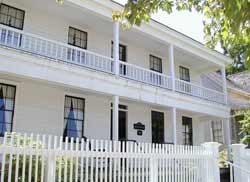The Monteiths
 In 1847, Walter and Thomas Monteith arrived on the future site of Albany and purchased the Smead claim for $400, as well as an adjacent claim. Town lots were laid out on a portion of claims on the east bank of the Willamette River, just below the mouth of the Calapooia River and a new town had been founded. The city was named Albany, after the Monteith's home state capitol, Albany, New York.
In 1847, Walter and Thomas Monteith arrived on the future site of Albany and purchased the Smead claim for $400, as well as an adjacent claim. Town lots were laid out on a portion of claims on the east bank of the Willamette River, just below the mouth of the Calapooia River and a new town had been founded. The city was named Albany, after the Monteith's home state capitol, Albany, New York.
 In 1849, the Monteiths built Albany's first frame house, which still stands at 518 Second Avenue S.W. as a museum open to the public.
In 1849, the Monteiths built Albany's first frame house, which still stands at 518 Second Avenue S.W. as a museum open to the public.
In 1850, Abram Hackleman, son of Abner Hackleman, laid out 70 acres on the east side of Albany for future development.
Hub City
The California Stage Company, the first major coachline in the west, began operation in Oregon in 1860 with coaches leaving daily from Portland to Sacramento. Albany was a stopover point in Linn County before proceeding southward. The first coach from Portland arrived in Sacramento six days and five hours later. Each coach carried 19 passengers, one driver and the mail. Four-horse teams were used in the summer and six-horse teams in the winter. The 710-mile route was the longest in the nation. A fare from Portland to Albany was ten dollars.
Steamboats brought the farmers and townspeople the necessities of life and enhanced prosperity in Albany. Boats running upstream carried mail, sheep, cattle, kerosene and everyday items for the farms, homes and mills. Many products such as flour, woolen goods and pottery went downstream to be shipped off to market. The first steamboat in Albany, the "Multnomah," had been built in New York City, shipped in pieces around Cape Horn, and reassembled in Oregon City. In 1870, a person could travel to Portland by steamboat for one dollar.
In 1871, the first locomotive whistle was heard in Albany. Albany businessmen raised $50,000 to ensure that the rails would come through their city, instead of bypassing it a few miles eastward. The train brought the farmers' markets close as stagecoaches and steamboats gave way to the railroad. The world's longest wooden railroad drawbridge was built in 1888 for the Albany-Corvallis run. By 1910, 28 passenger trains departed daily from Albany going in five different directions.
Albany became the manufacturing and transportation hub of the Willamette Valley. Foundries, blacksmith shops, furniture factories, tanneries, a bag factory, carriage factories, flour and flax mills, a twine factory, creameries and sawmills supplied local farmers and processed their crops. Flour, grain and produce were shipped by river and rail to Portland and points east.
A Living Museum
The city grew and prospered at a slow and steady pace. Each year, houses and commercial buildings were built in styles fashionable at the time. New industry moved to the outskirts, the main highway bypassed the downtown and post-World War II housing developed outside the original core of the city, leaving the old downtown and residential neighborhoods almost intact.
Today Albany is credited by historians and architects with having the most varied collection of historic buildings in Oregon. This collection includes styles from the 1840s through the 1920s and is concentrated within an area of approximately 100 square blocks. Three Albany Historic Districts are listed in the National Register of Historic Places by the United States Department of the Interior.
Albany College
 The Oregon Legislature chartered the Albany Collegiate Institute in February 1867 and Albany residents raised $8,000 in cash and promissory notes to erect a building for the school on land donated by Thomas and Walter Monteith. Rev. William Monteith became the first president of Albany College and 86 students enrolled in 1869. Four women comprised the first graduating class in 1873.
The Oregon Legislature chartered the Albany Collegiate Institute in February 1867 and Albany residents raised $8,000 in cash and promissory notes to erect a building for the school on land donated by Thomas and Walter Monteith. Rev. William Monteith became the first president of Albany College and 86 students enrolled in 1869. Four women comprised the first graduating class in 1873.
In 1905, the college purchased 46 acres on the edge of town for a new campus. Beset by the Great Depression, in 1934 the trustees authorized class offerings in the Portland area. The last class graduated from the Albany campus in 1938. The campus was sold to the U.S. Bureau of Mines.
In 1941, Albany College became Lewis & Clark College and moved to the campus on Southwest Palatine Road, Portland. Today, Lewis & Clark College is the state's largest private college with 1,600 undergraduates and over 1,100 graduate students in law, education, counseling psychology, and other programs.
 The college affirms its history and its presence in Albany. Albany Hall, a quadrangle of buildings on the campus, speaks to that heritage. The college also has the original foundation cornerstone of the Albany Collegiate Institute, the brass keys to the building's doors, the original cash box, and many other historical objects, documents, and photographs related to its origins in Albany.
The college affirms its history and its presence in Albany. Albany Hall, a quadrangle of buildings on the campus, speaks to that heritage. The college also has the original foundation cornerstone of the Albany Collegiate Institute, the brass keys to the building's doors, the original cash box, and many other historical objects, documents, and photographs related to its origins in Albany.
Resources to Learn More
- Albany Visitors Association
- Self-Guided Driving/Walking Tours
- Albany Regional Museum
- Linn County History Museum




